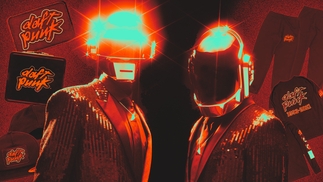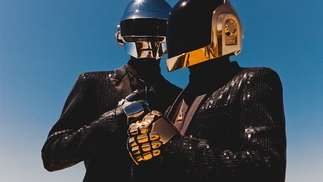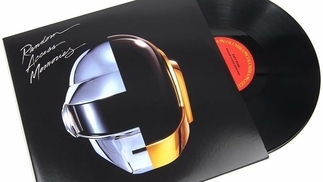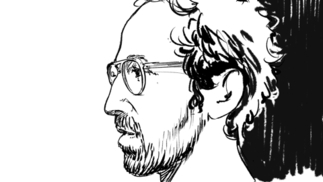TIM GANE RETURNS TO THE CAVERN OF ANTI-MATTER
Tim Gane on why music is like a tapeworm and that time Daft Punk slipped him a demo...

In 1990, Tim Gane formed post-rock superstars Stereolab with Laetitia Sadier who would go on to become his partner (until 2004) and the mother of their son. After 19 years as one of the most influential indie bands refitting retro-pop with futuristic structures, Stereolab called it quits in 2009, before the release of their final album, ‘Not Music’ in 2010.
Cavern of Anti-Matter, once a side project, has become an official band for Tim Gane, along with Joe Dilworth (Stereolab/Th’ Faith Healers) and Holger Zapf. They released their first album, 'Blood-Drum' in 2013. Their new album, ‘Void Beat / Invocation Trex’ – featuring Deerhunter's Bradford Cox, Mouse on Mars’ Jan St. Werner and Spacemen’s Sonic Boom – sounds like Can crashing a garage rock party.
The album is out now on Stereolab's Duophonic label. We caught up with Tim to discuss his new sound, how meeting groupies can be a good thing and what it was like being in Berlin when Bowie died.
How have you been keeping busy?
“I’ve been doing things like soundtracks. I’ve been making music but I haven’t been talking about it.”
Is Cavern still a side project or is it a “real” band?
“This isn’t a side project anymore. Cavern is the main thing I’m doing for the moment. I haven’t done any kind of band at all since Stereolab. I’m still trying to do other things. It’s not a project away from a bigger band. It is the band.”
What about Stereolab?
“It’s not impossible that we might try to do something. We’re all still alive. There’s nothing on the horizon or in my mind. I wouldn’t say it’s never going to happen. If there was something interesting in keeping with the way it worked, I’d be interested in doing it again. It wouldn’t be anything like a U2 concert.”
What’s it like going from being in a band to working solo to being back in a band?
“A Berlin label was asking me for music – Grautag. I thought they wanted a single. They said, 'No' we only do double albums. So I went, 'Oh...' but then I started messing around. It was kind of like working on the soundtrack. So we did a few tracks and the album came out and I thought that would be that. Then the label did a showcase. And they wanted us to play for it. So we did the one gig. Then we decided to do one more and then one more and one more and blah blah blah. It was not intentional that we would be a band. At the end of Stereolab I was tired of being in a band. I thought soundtracks would be the best thing to do. I’m not a fan of touring, but when you’re playing live on stage, that’s where you get some of the best ideas. You don’t get that in the studio.”
How do you combine the two?
“We try to utilize that live dynamic on this record. Five or six tracks were two or three improvisations on top of a sequence or riff. A song’s like a tapeworm: there’s a head which is written and it grows a tail and that goes where it goes.”
Is there any track overlap between your soundtrack work and the band?
“The last track with the piano ['zone null'] – that was done for a soundtrack. It was cut by the distributor, so I went back and messed around with it a bit but kept the bare bones. The track with Bradford Cox singing on it ['liquid gate'], was originally done for a film, for a 15 second piece of background music, for a party scene.”
How did you connect with Deerhunter?
“Bradford came to see us in Atlanta whenever Stereolab would play there. He was one of our fans always waiting for us. I remember this skinny guy, very talkative. This was around 1999. And later on it turned out he was in this band. Years go by and we got back in contact. I remembered him from then. He got me out of a tight spot when I needed a singer.”
So there’s still hope to hanging around as a groupie...
“There is, sometimes. In late 1991 these two guys came up to me at our first gig in Paris. They gave me a cassette they’d done. I loved the tracks on the cassette. They were called Darlin' then. Then they changed their name to Daft Punk. Another one was Broadcast around 1995.”
You can put that Daft Punk cassette on eBay.
“Now I wouldn’t sell it, but I actually want to hear it.”
How’d Jan St. Werner from Mouse on Mars wind up on here?
“I had this track and we played it live and he heard about a year ago and liked it. He wanted to use it for some idea. I sent him the tracks. He put a version of it together, using his electronic sound. I really liked it and asked if I could use some of those sounds for the LP. He made quite a great version for it. All the electronics on the LP are done live. There’s no real software involved. That’s a whole other world we don’t use. But someone like Jan can get all kinds of sounds from that.”
Mouse on Mars are like spiders they catch every sonic vibration out there. How’d you meet?
“We were both on Too Pure at the time. We went down to their first gig, I think. We’d done a few tours together, been to their studio. We got to like each other even though our styles were very different.”
Does location affect music? Is there a Berlin sound to this album – krautrock, for example.
“I got asked the other day to do eight tracks on a theme. On the spot, I thought I’ll do something on Berlin. I went through a few records I liked and it’s not any clearer to me after that if there is a “Berlin” sound. These were records I already liked anyway – krautrock, some minimal techno, post-punk. These things were “very Berlin” and they may have influenced me that way a little bit then but it’s not deliberate. When you get here, though, I must say, you are more immersed in the club world, it’s more minimal, more techno, harder. It rekindled a lot of stuff I used to like. The choice of instruments I make, old sequencers, for example. Stereolab never used synths. I wanted to have these things now. I wanted to react to them as new things. That could lead you to think there’s a Berlin influence, but it’s not a conscious thing. I’m not going to move to the tropics and start making bongo music.”
How’d you get into krautrock?
“When I first heard Neu!, it was in 1981. I was really into Throbbing Gristle, Cabaret Voltaire. Someone told me there was something more weird that that. I said ‘More weird?’”
Bowie was a big part of Belin for a while. Where you there when he died?
“I heard a Bowie song on the radio in the morning. Then they played another one. And another. Then they announced it. After the initial shock and sadness, I tuned it out.”
Ever have a chance to work with him?
“No, no. I was a big fan, but we never did. I remember when I was 12 going to the news agent to buy my first LP which was Elvis Costello’s ‘This Year’s Model’ - for some reason they sold LP’s then – and I heard this amazing track. It sounded 3D. I remember standing there, feeling it was right in my ear. It was ‘Sound and Vision’ by Bowie. And I had heard it on the radio, but standing in the news agent’s it really sounded so crazy to me. When I listened to that track as a kid, it made me want to do music.”
Let’s talk about some of the tracks. ‘blowing my nose...’ has an almost Arthur Baker electro vibe. Can you see breakdancing here?
[Laughs] “It was just a random thing I taped. I was trying to do some drum machine programming but I’m really bad. The way I get something more interesting is adding a delay to it. All of a sudden this drumbeat came out, so I put it through all these effects and had all these versions to it. The delays give it a slight triplets feel. It wasn’t really a band track. It was just me and Holger. It’s different from the others, so I thought it was good to have. I like it a lot because I don’t really recognize myself in it. This one is reacting to things that are happening and trying to capture it. That was reason enough to put it on the album. It’s one of my favorites on the record, actually. I’m kind of surprised by it. I just got the final copy of the record. I hadn’t listened to it in a couple months. I put it on and thought, ‘Hey, that’s pretty good...’”
Another favorite is ‘insect ear’. What’s the story there?
“We had a track that was very long – about 35 minutes long. It’s on the LP in two parts, ‘insect ear’ and the other half morphed into ‘void beat’. They have the same drum machine on them. It’s one of the most problematic tracks on the album. We did it live and it was good, but when we went to record it, it didn’t work well. So we cut it to three minutes. We couldn’t capture the same intensity. I think it was works a lot better shorter. I didn’t want it to follow the same recipe as the rest of the album.”
‘liquid gate’ is pretty close to a pop song...
“Close as I ever get. I didn’t put it before the pop committee or anything but it’s my idea of pop. It was recorded like a year and a half ago, after the first LP. I thought the vocals were good but the rest wasn’t it. I wasn’t even thinking about it for the LP. It’s short, it’s to the point, and quite in opposition to the longer tracks on the album. It’s a nice contrast, so I thought, ‘Let’s put it somewhere.’ It’s a funny process. You never know how it’s all going to work while you’re in it, putting it together, then you get the final product and all the layers fit together well. The whole process of making the record, of going from beginning to end, that’s what really makes it exciting. The final record is only half of what you went through. The process can take you places you never knew you were going. I’m trying to strike a balance between controlling things and just letting them go.”





